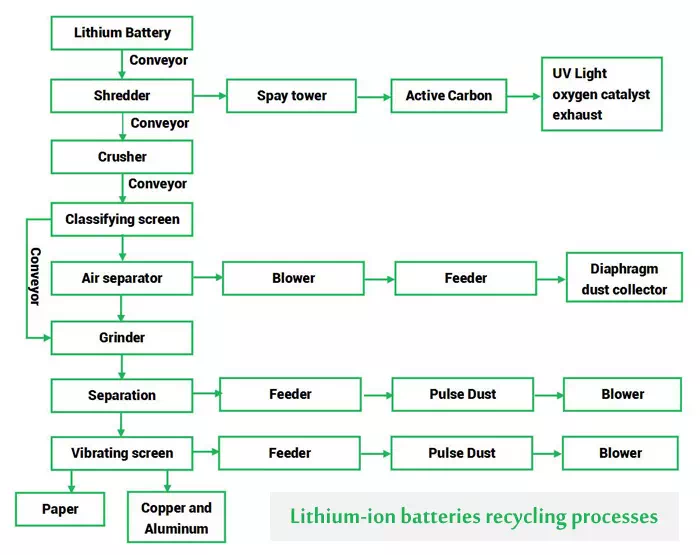News
Lithium-ion batteries recycling processes and technologies
Time:2023-01-04 17:05:53
Lithium-ion batteries are made up of positive and negative electrodes, binder, electrolyte and diaphragm. In industry, manufacturers mainly use lithium cobaltate, lithium manganate, lithium nickel cobalt manganate ternary materials and lithium ferrous phosphate as the cathode material for lithium ion batteries, and natural and artificial graphite as the cathode active material. Polyvinylidene fluoride (PVDF) is a widely used cathode binder with high viscosity and good chemical stability and physical properties. Industrially produced lithium-ion batteries mainly use a solution configured with the electrolyte lithium hexafluorophosphate (LiPF6) and organic solvents as the electrolyte and organic films, such as porous polymers like polyethylene (PE) and polypropylene (PP), as the diaphragm for the battery.
The recycling process of used lithium-ion batteries mainly includes pre-treatment, secondary treatment and deep treatment. As there is still some electricity left in the used battery, the pre-treatment process includes deep discharge process, crushing, physical sorting; the secondary treatment aims to achieve complete separation of the positive and negative active materials from the substrate. The commonly used recycling method is dry physical and mechanical recycling.
The physical sorting method refers to the disassembly and separation of the battery, the electrode active material, the collector fluid and the battery shell and other battery components by crushing, sieving, magnetic separation, fine crushing and sorting, so as to obtain a valuable high content of material. In the proposed method for recovering Li and Co from lithium-ion battery waste streams using sulphuric acid and hydrogen peroxide, 2 processes are included: physical separation of metal-containing particles and chemical leaching. In particular, the physical separation process includes crushing, screening, magnetic separation, fine crushing and sorting. The experiment utilises a set of rotating and fixed blade crushers for crushing, sieves of different apertures for sorting and crushing the material and magnetic separation for further processing in preparation for the subsequent chemical leaching process.
Henan Recycle has developed a new method of recovering cobalt and lithium from lithium-sulphur battery scrap using mechanochemical methods. The method uses a planetary ball mill to co-grind lithium cobaltate (LiCoO2) and polyvinyl chloride (PVC) in air to form Co and lithium chloride (LiCl) in a mechanochemical manner. The grinding product is then dispersed in water to extract the chloride. The grinding facilitates the mechanochemical reaction. As the grinding progresses, the extraction yield of both Co and Li is increased. 30 min of grinding results in the recovery of over 90% Co and nearly 100% Li.
The physical sorting method is simple, stable and efficient and can effectively separate out the precious metals and and useful substances such as black powder inside for the reuse of lithium batteries. If you have questions about lithium batteries, please feel free to contact us for advice.
LATEST NEWS
CONTACT US
Tel: 0086-13674945231(whatsapp)
Email: sunymachine@gmail.com
Add: Henan Communication Industrial Park) 5th St., Economic-Technological Development Zone, Zhengzhou
